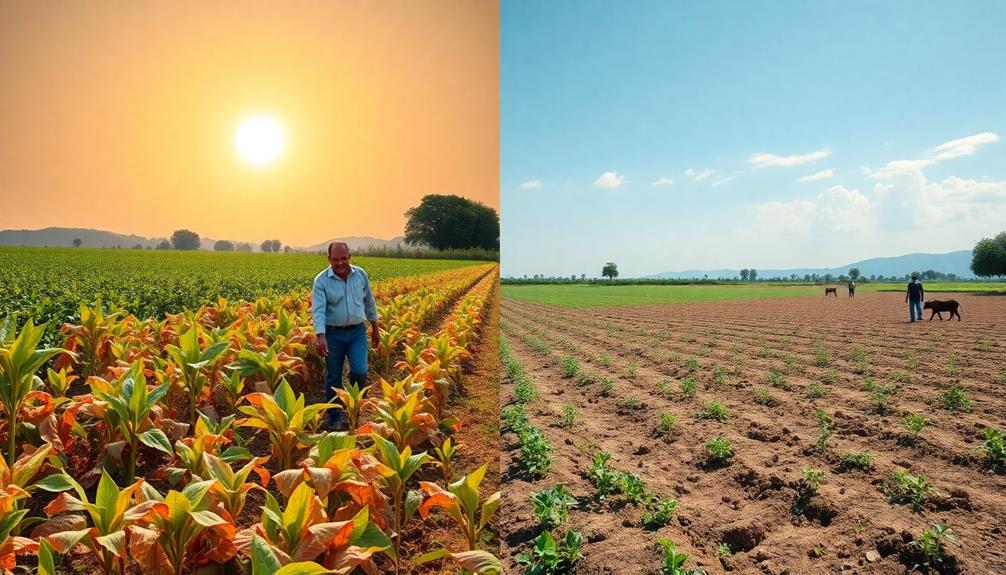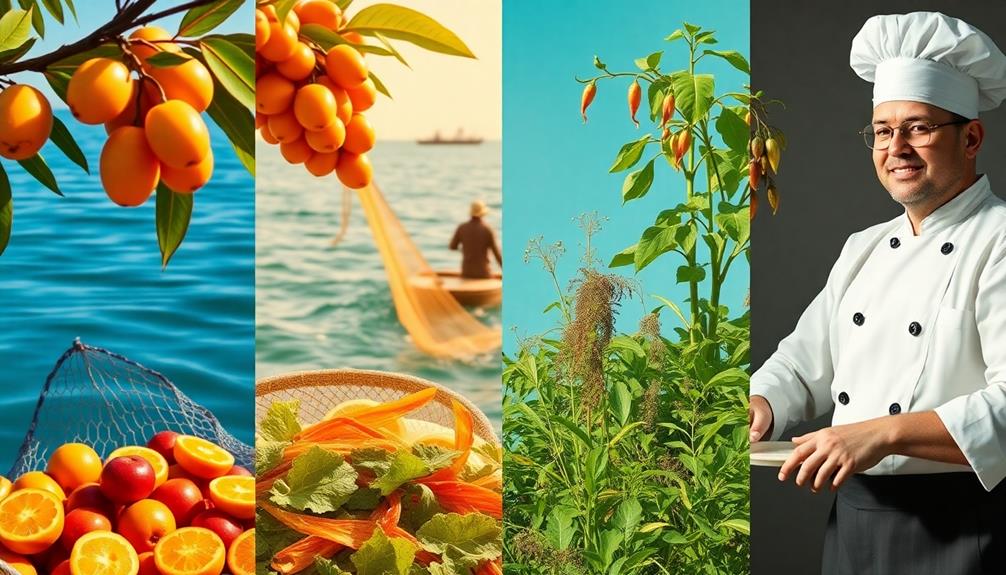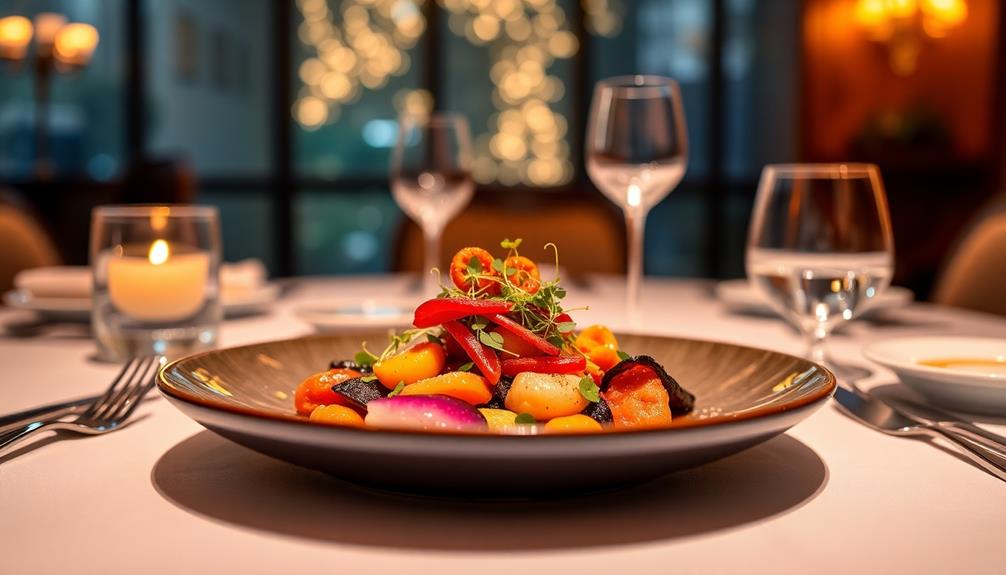Climate change is reshaping global cuisines in unexpected ways. You might notice how rising temperatures impact local ingredients, making traditional dishes harder to prepare. For instance, the beloved Gallo Pinto in Costa Rica is threatened by declining rice yields. Chefs are adapting by incorporating resilient crops and alternative proteins into their recipes. This shift not only preserves culinary traditions but also emphasizes sustainability. As seafood options dwindle, coastal communities are experimenting with new flavors and cooking techniques. This evolving landscape invites you to explore how the world's kitchens are innovating amid these challenges.
Key Takeaways
- Climate change threatens local ingredients, impacting traditional dishes like Gallo Pinto and Poutine due to reduced crop yields and availability.
- Rising temperatures and ocean conditions jeopardize seafood supplies, affecting classic meals like Jamaica's Ackee and Saltfish and Italy's pasta.
- Chefs are adapting by utilizing resilient crops, local ingredients, and innovative techniques to maintain culinary heritage amidst changing environments.
- Traditional cooking methods are being reimagined, incorporating preservation techniques like fermentation to cope with ingredient scarcity.
- The shift towards fusion cuisine and alternative proteins reflects a commitment to sustainability and ecological responsibility in global culinary practices.
Effects on Local Ingredients

Climate change is reshaping local ingredients and, in turn, the dishes that define cultures worldwide. As temperatures rise, the food supply becomes increasingly threatened.
For instance, in Costa Rica, altered precipitation patterns jeopardize rice yields, which are vital for Gallo Pinto, a beloved staple. Similarly, in Angola, the availability of key ingredients like palm oil and okra for traditional dishes such as Muamba De Galinha may also be impacted. If these patterns continue, you might find it hard to enjoy this traditional dish as the agricultural viability declines.
In the UK, climate change is projected to reduce suitable land for potato production by a staggering 74% by 2050. This decline could deeply affect dishes reliant on potatoes, altering the culinary landscape you know.
Similarly, rising ocean temperatures endanger cod populations essential for Jamaica's Ackee and Saltfish, with each degree potentially reducing catch by 0.44%.
Additionally, heat stress impacts duck growth rates in China, threatening the quality of Peking Duck.
In Italy, early heatwaves have historically led to significant declines in durum wheat crop yields, crucial for pasta production.
With extreme weather events becoming more frequent, the availability of these local ingredients is at risk, and you might soon notice how climate change is reshaping your favorite meals.
Shifts in Traditional Dishes

As climate change reshapes our environment, traditional dishes are facing significant shifts due to crop yield reductions and changes in ingredient availability.
For instance, the rising temperatures and unpredictable weather could affect the growth of key ingredients used in classic Italian cuisine, such as tomatoes for pasta with tomato sauce.
You might notice how beloved meals, from Canada's poutine to Jamaica's ackee and saltfish, are at risk as their key components become harder to source.
This evolution in our food landscape raises important questions about the future of our culinary heritage.
Crop Yield Reductions
Significant reductions in crop yields due to climate change are reshaping traditional cuisines worldwide. As climate change progresses, food production faces challenges that directly impact beloved dishes.
For instance, in Central America, smallholder rice crops could drop by 15-25% by 2050, threatening staples like Gallo Pinto in Costa Rica. Extreme weather events exacerbate these issues; the 2018 heatwave in Canada led to the abandonment of 6,475 hectares of potato crops, affecting the production of Poutine, a cherished national dish.
In Brazil, similar challenges could affect traditional dishes like Caldeirada, as seafood resources become strained due to rising ocean temperatures. Italy's pasta production is also at risk; early heatwaves can cause durum wheat yields to decline, as seen in the historical losses from 2003.
Rising ocean temperatures further threaten marine species, like cod in the North Sea, which are crucial for traditional dishes such as Jamaica's Ackee and Saltfish. Even in Japan, climate change is impacting rice yield and quality, jeopardizing the specific rice varieties essential for preparing Sushi.
These crop yield reductions not only challenge food security but also disrupt the cultural fabric woven into our traditional dishes. As global warming continues, the future of many cherished cuisines hangs in the balance.
Ingredient Availability Changes
The ongoing shifts in ingredient availability due to climate change are threatening the essence of traditional dishes worldwide. As climate change progresses, the impacts of climate on food production become increasingly evident.
For instance, in Central America, rice production could decline by 15-25% by 2050, jeopardizing beloved dishes like Costa Rica's Gallo Pinto. Extreme weather events and altered weather patterns are also disrupting black bean cultivation, another key ingredient for Gallo Pinto and various other recipes.
Similarly, in Indonesia, rising temperatures may affect the availability of essential ingredients like rice flour and palm sugar, critical for traditional desserts such as Kue Putu and Dadar Gulung.
In the UK, suitable land for potato production may plummet by 74%, impacting Canada's famous Poutine, which relies heavily on this staple.
Even seafood isn't safe; rising ocean temperatures are diminishing sustainable cod yields, fundamental for Jamaica's Ackee and Saltfish, with each degree of warming reducing cod catches by 0.44%.
Moreover, early heatwaves have historically caused significant declines in durum wheat yields, directly affecting pasta availability in Italian cuisine.
These shifts in ingredient availability not only alter recipes but also challenge cultural heritage, forcing communities to adapt or risk losing their culinary identities. The future of global cuisines hinges on our response to these changes.
Adaptations in Culinary Practices

As climate change reshapes food availability, you'll notice chefs increasingly turning to local ingredients, reimagining traditional cooking techniques to adapt.
For instance, the rise in temperatures and shifting agricultural patterns may influence the use of staple ingredients, leading to innovative dishes like Sichuan Cold Noodles that celebrate seasonal produce.
This shift not only helps sustain culinary heritage but also sparks exciting fusion cuisine trends that blend cultures and flavors.
Local Ingredient Sourcing
Amid evolving climate conditions, chefs are increasingly turning to local ingredient sourcing to adapt their culinary practices. Climate change has prompted a shift in focus, leading to the selection of ingredients that can withstand new challenges.
For instance, in Indian cuisine, chefs might incorporate spices enhancing dishes that are more resilient to climate changes.
Here's how this trend is reshaping global cuisines:
- Heat-tolerant crops: Chefs are incorporating varieties that thrive in warmer climates, ensuring consistent availability.
- Indigenous plants: Regions like Costa Rica are seeing a resurgence in local rice and bean varieties, which are more resilient to extreme weather.
- Resilient seafood species: Coastal communities are exploring alternative local seafood, adapting to the decline of traditional fish populations caused by rising ocean temperatures.
- Seasonal shifts: In Greenland, increasing vegetable production has introduced new local ingredients, such as potatoes and strawberries, into traditional diets.
Traditional Cooking Techniques
Adapting traditional cooking techniques is essential as climate change impacts ingredient availability and culinary practices worldwide. You'll notice that chefs are increasingly incorporating resilient crops and locally sourced alternatives to combat reduced agricultural yields.
For instance, ingredients like Umeboshi (Pickled Plum) are being utilized for their preservation qualities, allowing for a more sustainable approach to traditional recipes. This shift not only supports sustainability but also encourages creativity in the kitchen.
In regions facing challenges, culinary practices are evolving to embrace preservation methods like fermentation and pickling. These techniques extend the shelf life of ingredients, ensuring that you can enjoy a taste of the season long after the harvest.
Meanwhile, rising global temperatures are affecting cooking times. In hotter climates, chefs are adjusting recipes to accommodate the heat sensitivity of certain ingredients, making precision more critical than ever. This shift is particularly evident in baking, where even slight temperature variations can alter the outcome of recipes. Humidity’s impact on baking results further complicates matters, as it can affect everything from dough hydration to the texture of delicate pastries. As a result, culinary experts are finding innovative ways to adapt, such as tweaking ingredient ratios or employing advanced kitchen technologies to maintain consistency.
As seafood populations shift due to warming oceans, traditional seafood dishes are being reimagined. You might find alternative fish species or even plant-based substitutes on your plate, reflecting the changes in local marine biodiversity.
Culinary schools are recognizing these shifts too, integrating climate resilience training into their curricula. This prepares future chefs to innovate traditional recipes while considering sustainability and the environment, ensuring that our culinary heritage adapts to the challenges ahead.
Fusion Cuisine Trends
Fusion cuisine trends are reshaping how we think about food in the face of climate change. As traditional ingredients become scarce, chefs creatively blend global flavors and culinary practices, embracing sustainability and climate-resilient ingredients.
For instance, dishes like Chilaquiles may see adaptations with alternative proteins to guarantee they remain a staple while reflecting modern dietary shifts. Here are some key aspects of this culinary evolution:
- Alternative Proteins: Chefs incorporate plant-based proteins into classic meat-heavy dishes, redefining traditional recipes to meet rising food demand sustainably.
- Local Sourcing: With climate-induced crop failures, chefs are turning to locally sourced ingredients, guaranteeing that dishes reflect both cultural significance and ecological responsibility.
- Innovative Techniques: In regions facing severe climate impacts, like coastal areas losing fish stocks, chefs are creatively integrating land-based proteins and alternative seafood sources, reshaping local culinary landscapes.
- Biodiversity Preservation: The fusion cuisine trend often responds to the loss of biodiversity in traditional foods, prompting chefs to experiment with new flavors while honoring the cultural heritage of their dishes.
Through fusion cuisine, you're not just tasting a meal; you're experiencing a response to climate change, embodying a commitment to sustainability and the celebration of diverse culinary traditions.
Economic Implications for Farmers

Facing the reality of climate change, farmers are grappling with significant economic challenges that threaten their livelihoods. You're likely feeling the pinch as heavy rains and extreme weather events disrupt your crops and livestock.
For instance, smallholder rice farmers in Central America could see yields drop by 15-25% by 2050, severely impacting food supply and farmers' incomes in the region. In the UK, potato yields may decline by 20-25% due to unpredictable weather, which will inevitably increase costs and reduce profitability in an essential agricultural sector.
Additionally, the changing climate could also influence the availability of traditional ingredients for comfort food, such as corn for creamed corn, further complicating the economic landscape for farmers.
Furthermore, rising temperatures are causing increased mortality rates in dairy cows, leading to higher operational costs and losses in milk production. As you face these heat impacts, the need for mitigation strategies could drive prices up for consumers, impacting your competitiveness in the market.
The North Sea's warming is further complicating matters, threatening cod sustainability and fishermen's livelihoods.
In this rapidly changing environment, adapting is imperative. If you can find innovative solutions to these challenges, you mightn't only protect your income but also contribute to a more resilient food system.
Global Food Security Challenges

As the global population surges towards nearly 10 billion by 2050, food security challenges intensify, threatening the very foundation of sustenance for millions. Climate change exacerbates these challenges through extreme weather and rising temperatures, leading to significant declines in food production.
For instance, traditional Ethiopian foods like Yekolo (Roasted Barley) could face production challenges due to changing climates, impacting their availability as a staple in the diet.
Consider the following key impacts:
- Global vegetable and legume yields could drop by 35% by 2100 without emission reductions, jeopardizing food security for vulnerable populations.
- Historical droughts in wheat-producing countries have sparked food riots, showing how climate-induced crop failures can lead to social unrest.
- In Central America, rising temperatures and unpredictable weather may reduce smallholder rice crops by 15-25% by 2050, impacting a staple food source.
- Declines in production are expected to increase food prices, making access to food even more difficult for the poorest and widening the rich/poor divide in food resources.
These factors create a ripple effect, threatening not just availability but also the stability of food systems worldwide.
It's crucial to address these challenges now, as they'll shape the future of global cuisines and food security for generations to come.
Innovations for Sustainable Cuisine

Amid the pressing challenges of climate change, innovative approaches to sustainable cuisine are emerging as vital solutions. Organizations like the Food Action Alliance are training 20 million farmers on new agricultural standards that emphasize sustainability, helping to enhance food production practices. This training is important as it adapts to the realities of climate change.
In Greenland, innovations like vertical farming are transforming local food independence, allowing communities to grow food despite harsh weather and short growing seasons. This method not only supports local cuisines but also promotes biodiversity by diversifying the types of crops grown.
The First Movers Coalition's commitment of $12 billion to decarbonize the cement and concrete industry indirectly bolsters sustainable infrastructure for food production and distribution.
Meanwhile, community engagement initiatives educate the public about the impacts of climate change on food systems, encouraging adaptive practices that sustain traditional and local cuisines.
Lastly, the 1t.org initiative aims to plant 1 trillion trees by 2030, enhancing biodiversity and ensuring a variety of sustainable food sources for global cuisines.
Together, these innovations pave the way for a more resilient and sustainable food future.
Frequently Asked Questions
How Does Climate Change Affect the Global Food System?
Climate change disrupts your food system by altering crop yields, threatening biodiversity, and shifting growing regions. You'll face higher prices, food scarcity, and changes in availability, ultimately affecting your diet and culinary traditions.
How Does Climate Affect Cuisine?
Imagine your favorite dish fading away as crops struggle. Climate affects cuisine by altering ingredient availability, shifting flavors, and pushing chefs to adapt. You'll find familiar tastes transformed, making every meal a reflection of changing times.
How Is Climate Change Affecting the World Globally?
Climate change affects you globally by altering weather patterns, increasing extreme events, and disrupting ecosystems. These shifts lead to reduced crop yields, impacting food security, water availability, and biodiversity, ultimately threatening your everyday life and well-being.
How Is Food Contributing to Global Climate Change?
When you savor a meal, remember that your food's journey impacts our planet. Agriculture, especially beef and rice, emits greenhouse gases. Wasting food only amplifies the problem, contributing greatly to climate change's relentless march.
Conclusion
As you savor your next meal, think about the journey of each ingredient, shaped by a warming planet. The vibrant tomatoes you relish might've once thrived in cooler climates, now struggling under the sun's relentless gaze. With every bite, you're not just tasting tradition but witnessing transformation. Embracing sustainable cuisine is like planting seeds of hope for the future—nurturing a world where flavors meld with resilience, creating a tapestry of tastes that tells the story of adaptation.










